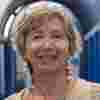Thanks to our Curestarters and some cutting-edge chemistry detective work by Dr Simona Polo and her team in Italy, we are one step closer to a brand new treatment for cancer patients. While it's still early days, Dr Polo is hopeful that her new discovery, which is based on the structure of a well-known antidepressant molecule, could ultimately lead to potent new cancer treatments.
These findings offer great premises for the development of new therapeutics targeting tumors sensitive to NEDD4 expression and activity.

Unlocking a new solution to a very old problem
Dr Polo’s new discovery is based on a very specific molecule called NEDD4. NEDD4 is hugely important for cancer cells. It is part of highly specialized machinery that cells need to break down and ‘recycle’ old proteins.
Many types of cancer have very high levels of NEDD4, including breast, bowel, and brain cancer, among others. All of this makes NEDD4 a good target for new drugs. But until now, no one has been able to find a way to target it.
Dr Polo decided to go back to basics and investigate exactly how NEDD4 interacts with an antidepressant molecule called norclomipramine, which is produced in our body when we metabolise the antidepressant clomipramine.
Researchers have long known that norclomipramine can block NEDD4 and stop it working efficiently. But they haven’t been able to find out how it does this, until now.

What did the researchers discover?
The team used a special technique called ‘X-ray diffraction’ to study the shape and structure of norclomipramine as it physically interacts with a NEDD4 molecule.
They found that norclomipramine sticks tight to a special shaped ‘pocket’ on the NEDD4 protein, which stops NEDD4 from interacting with other molecules that normally use the pocket.
The team then designed and synthesised a selection of brand-new molecules that can potently block the same area of NEDD4, in a similar way to norclomipramine. They carefully selected molecules that can bind to NEDD4 very strongly, to make these potential new cancer drugs as potent as possible. They also selected molecules that did not bind to anything else. This lowers the risk of serious side-effects.
Finally, the team studied these designer molecules in the lab, to select the most promising candidate for a new cancer drug. One of the molecules, called ‘Compound 32’, worked particularly well, and also had the potential to be effective when given in tablet form.

What does this discovery mean for cancer patients?
Every single medical breakthrough and new cure starts with a bright idea, and the curiosity and support to follow that bright idea through.
Thanks to the support of our Curestarters, Dr Polo and her team not only found a way to target an important cancer molecule, they have also developed a new drug molecule which could one day lead to a brand-new type of cancer cure.
Of course, it is early days yet, and developing a brand new cure takes years. This molecule must now be rigorously tested in the lab, and researchers must assess whether it is safe enough for patients, and if it could be effective against cancer.
After this, it can be tested in patients and, hopefully, one day it could mean that fewer lives will be cut short by cancer.

Join our united effort to stop cancer.
There are so many different ways to support our search for new cures. Will you join the 90,000+ Curestarters who are already helping us get closer to a day when no life is cut short by cancer?




